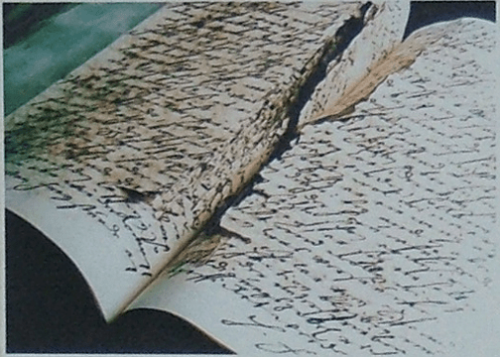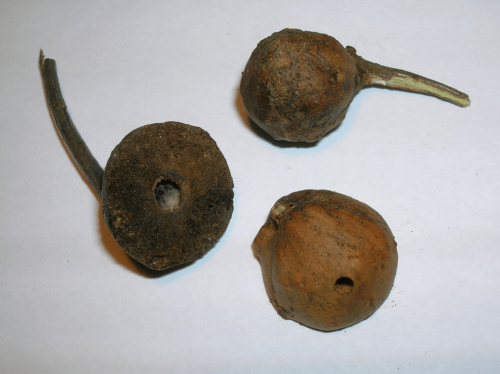
Today’s pens combine pen and ink into a convenient vessel, ready for instant use. In Austen’s day, pen and ink were separate entities, both of which needed to be available in order for writing to be possible.
Inks of various compositions and qualities were available during the Regency era, both homemade and purchased. The properties of good ink were widely agreed upon.
The chief requisites for the making of good ink, are:
1. Limpidity. so that it may flow freely from the pen.
2. A deep. uniform and black colour.
3. Durability. so that the letters be not liable to be effaced by age; and
4. It should be divested of any corrosive quality, by which the substance of the paper may be destroyed, or the writing rendered in any illegible.
No ink, however, hitherto used, possesses all these properties; hence several ingenious chemists have been induced to make experiments, in order to render it more perfect.
~The Domestic Encyclopedia
Making Ink
As with many goods, ink was often made at home. Recipes for ink were widely available in domestic encyclopedias and household management books and utilized items easily available from local sources including the garden, the grocer, and the apothecary. Some of these items might not be familiar so here’s a quick glossary of terms from the recipes.
Glossary of Terms
Allepo galls: galls produced by an Allepo Oak tree
Alum: astringent compound of aluminum and potassium sulphate; mordant that fixes dyes in a material
Avignon berry: also French berry, Persian berry. The fruit of the Avignon bukthorn
Blue galls: high quality galls
Blue Vitriol: copper sulphate; antimicrobial and fungicide
Ceruse: white lead
Cream of tartar: potassium bitartrate; byproduct of wine fermentation
Flake White: pigment made form white lead
Galls: an oak tree’s protective reaction to wasp eggs deposited under its bark.
Green Copperas, also green vitriol, also vitriol of iron, iron sulfate: ferrous sulfate; a mordant that fixes dyes in a material
Gum Arabic: a natural gum originally consisting of the hardened sap of two species of the Acacia tree; thickening and binding agent
Gum tragacanth, also gum adragant: viscous, odorless, tasteless, water-soluble obtained from sap that is drained from the root of certain legume (commonly called goat’s thorn and loco weed) and dried; binding agent especially suitable for powders
Gum water: A remedy for coughs and stomach complaints, made from boiling water and gum arabic.
Indigo: a species of plant used to create blue dye and the dye created from it.
litharge of gold: led oxide mixed with red led
Logwood, also Bloodwood: a species of flowering tree in the legume family, native to Central America and West Indies, produces dyes ranging from red-purples to blues.
Oil of Vitriol: concentrated sulfuric acid
Quick lime: also burnt lime; caustic, alkaline calcium oxide compound
Red Orpiment: deep-colored, orange-yellow arsenic sulfide mineral used in red pigments
Verdigris: poisonous, blue-green copper-based pigment from the patina on copper
Vitriolic acid: sulfuric acid
Recipes for black ink

Though admittedly imperfect, the two primary forms of black ink available were carbon black ink and iron gall ink. The former consisted of soot or lamp black that would then be blended with a weak gum or glue solution. Iron gall ink came from iron galls that were soaked with water, mixed with iron salts and fermented. The acidity of the ink bound it strongly to the paper, making forgery very difficult, but the same property also made it rather destructive to the paper.
Recipe for carbon black ink:
To make Indian Ink . Put six lighted wicks into a dish of oil ; bang an iron or tin concave cover over it so as to receive all the smoke ; when there is a sufficient quantity of soot settled to the then take it off gently with a feather upon a sheet of paper , and mix it up with gum tragacanth to a proper consistence in small portions ,. N. B. The clearest oil makes the finest soot , consequently the best ink
~The Domestic Encyclopedia

Iron gall ink was far more involved to make. In general, it was madeof four main ingredients:. Galls, an acidic solvent, such as beer or wine, (or perhaps more interestingly, allowing mold to grow on the gall nuts as they soak help produce gallic acid.) The acid improved the ink’s color. Ferrous sulfate which would react with gallic acid to produce a blue-black iron-tannin complex. Finally gum arabic which would keep pigment particles in suspension, bind ink to the writing surface, and improve the ink’s flow.
Despite its capacity to eat away the paper it was used on, Iron gall ink could be made very thin, so it would remain on the pen nib a long time, enabling the hairline stroke beautiful pennmanship required.
Recipes for Iron Gall Ink:
607 . To make Ink . To three quarts of water add three pints of white wine vinegar ; fifteen ounces of blue galls slightly bruised ; let these stand near a fire six days ; then put in six ounces of green copperas , and seven ounces of gum arabic finely pounded ; permit the whole to remain near a fire six days more , and be frequently stirred up ; strain the liquor through a fine cloth , and bottle it up for use . Remark . The vinegar improves the colour of the ink , but it has the troublesome effect of destroy ing the pen very quickly . Pronet says , the best ink is made by digesting the infusion of galls in pure water , upon iron . That process certainly makes a very good ink . The proper proportion of gum is of course added .
~New Family receipt book
187. To make good Black Ink . TAKE eight ounces of Aleppo galls in coarse powder , four ounces of logwood in thin chips , four ounces of sulphate of iron , ( green copperas ) three ounces of gum arabic in powder , one ounce of sulphate of copper , ( blue vitriol ) and one ounce of sugar candy . Boil the galls and logwood together in twelve pounds of water for one hour , or till half the liquid has been evaporated . Strain the decoction through a hair sieve , or linen cloth , and then add the other ingredients . Stir the mixture till the whole is dissolved , more especially the gum , after which leave it to subside for twenty – four hours . Then decant the ink , and preserve it in bottles of glass or stoneware, well corked .
~Manual of Useful Knowledge
Ink was sometimes made in a convenient powdered form. As such it was easier to store and could be made up fresh when needed:
Recipe for powdered ink:
Ink powder is prepared chiefly from the acid salt of galls, which may be obtained by the following process: Take two ounces of pulverized galls, infuse them in twelve ounces of rain or river-water; expose the for a few days to a warm temperature, and stir it occasionally: after having extracted the coloring matter, fiitre the solution. and suffer it to stand in the open air for several weeks, in a vessel slightly covered. A sediment will then be gradually formed; which, after removing the mouldy skin from the topof the liquor, should be carefully collected. Hot water is next poured on this sediment. when it is again filtered and evaporated to dryness: thus, a grey crystalline salt will be produced, that is the essential basis of black ink and which may be still more purified by repeated solution, filtration, and evaporation.
If one drachm of this salt of galls be triturated with an equal quantity of the purest vitriol of iron, and about twenty grains of perfectly dry gum-arabic, a composition will be obtained which, on adding a proportionate quantity of warm water, instantly affords an excellent black ink.
~Domestic Encyclopedia
Next time we’ll look at some fun colored inks. See you then!
Would you have been the sort to make your own ink, or would you have bought it? Tell me in the comments.
Find more posts on ink here.
Find more on the art of writing here.
References
Bugbee, Lindsey. Iron Gall Ink: A Timeless Favorite. The Postman Knocks. August 3,2021. Accessed March 3, 3023. https://thepostmansknock.com/iron-gall-ink-a-timeless-favorite/
Gupta, Anisha. The Ins & Outs of Iron Gall Ink. American Philosophical Society. February 25, 2021. Accessed March 7, 2023. https://www.amphilsoc.org/blog/ins-outs-iron-gall-ink
Hurford, Robert. Handwriting in the Time of Jane Austen. PERSUASIONS ON-LINE V.30, NO.1 (Winter 2009). Accessed 11/28/22. https://jasna.org/persuasions/on-line/vol30no1/hurford.html
Kane, Katheryn. Ink-Regency Writing Fluid. The Regency Redingote. September 18, 2009. Accessed December 12, 2022. https://regencyredingote.wordpress.com/2009/09/18/ink-regency-writing-fluid/
Pybus, William. A Manual of Useful Knowledge. Printed for the author by William Rawson: London 1810.
The New Family Receipt book. Squire and Warwick:London. 1811.
Willich, A. F. M. and Cooper, Thomas. The Domestic Encyclopedia. Abraham Small: Philadelphia. 1821.

3 comments
Yes, I make my own ink with walnut. We have a tree in the garden. I take the outer shell (black) and get the nut out of it. I cut the outer shells in small pieces and and let it stand for 2-3 days in a bottle with very little water and drops of alcohol. I filter it through a coffee filter and can use it for 3-4 weeks. I store the ink cold. I have a piston filler for ink in glassbottles. The coloring from walnut is from light to deep brown. I like to write and paint with it. Just for fun. Sometimes I put some rost in it. It makes very lovely effects when I paint on fabrics.
Thank you for the interesting article.
As always, your research and writing remind me of how much I take for granted! Thank you for these detailed descriptions of ink making!
ok, first of all, i want to say that i’m so glad i’m where i am now …
to have everything ready for me to write, to draw and to paint is such a luxury i am not willing to forsake.
and to think, i can even type my message here without any pen or ink!!!
Thank you, Maria, for sharing your researches which always remind me how lucky i am.